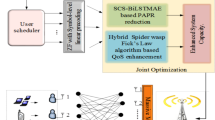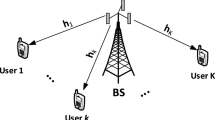Abstract
Transmission power control has been used in wireless networks to improve the channel reuse and/or reduce energy consumption. It has been mainly applied to single-input single-output (SISO) systems, where each node is equipped with a single antenna. In this paper, we propose a power-controlled channel access protocol for MIMO-capable wireless LANs with two antennas per node. Our protocol, called E-BASIC, extends the classic CSMA/CA access scheme by allowing for dynamic adjustment of the transmission mode and the transmission power on a per-packet basis so as to minimize the total energy consumption. By transmission mode we mean one of the four possible transmit/receive antenna configurations: 1 × 1 (SISO), 2 × 1 (MISO), 1 × 2 (SIMO), and 2 × 2 (MIMO). Depending on the transmitter-receiver distance, any of the four modes can be the optimal one in terms of minimizing the total energy consumption. We study the performance of E-BASIC in both ad hoc and access point topologies. We also incorporate E-BASIC in the design of a power-aware routing (PAR) scheme that selects minimum-energy end-to-end paths. Our adaptive designs are first conducted assuming fixed-rate transmission, but later extended to multi-rate systems. To account for the energy-throughput tradeoff in our designs, we impose a constraint on the average packet delivery time. Simulations indicate that the proposed adaptations achieve a significant reduction in the overall energy consumption relative to non-adaptive MIMO systems.










Similar content being viewed by others
Notes
Another approach to conserve energy is to put inactive nodes to sleep. Such an approach is complementary to TPC, and is not considered in this paper.
The feasibility of changing the antenna mode on a per-packet basis was demonstrated in several experimental MIMO platforms [28].
This is true only when MIMO technology is employed to achieve diversity gain. The situation is different in the case of multiplexing gain, which we do not address in this paper.
References
International Standard ISO/IEC 8802-11, ANSI/IEEE Std 802.11, 1999 ed., Part 11: Wireless LAN Medium Access Control (MAC) and Physical Layer (PHY) Specifications.
Gupta, P., & Kumar, P. R. (2000). The capacity of wireless networks. IEEE Trnansactions on Information Theory, 46(2), 388–404.
Monks, J., Bharghavan, V., & Hwu, W.-M. (2001). A power controlled multiple access protocol for wireless packet networks. In Proceedings of the IEEE INFOCOM Conference, Sept. 2001, pp. 219–228.
Wu, S.-L., Tseng, Y.-C., & Sheu, J.-P. (2000). Intelligent medium access for mobile ad hoc networks with busy tones and power control. IEEE Journal on Selected Areas in Communications, 18(9), 1647–1657.
Krunz, M., Muqattash, A., & Lee, S.-J. (2004). Transmission power control in wireless ad hoc networks: Challenges, solutions, and open issues. IEEE Network Magazine, 18(5), 8–14.
Agarwal, S., Krishnamurthy, S., Katz, R. H., & Dao, S. K. (2001). Distributed power control in ad-hoc wireless networks. In Proceedings of the IEEE International Symposium on Personal, Indoor, and Mobile Radio Communications (PIMRC), Sept. 2001, pp. 59–66.
Gomez, J., Campbell, A. T., Naghshineh, M., & Bisdikian, C. (2003). PARO: Supporting dynamic power controlled routing in wireless ad hoc networks. ACM/Kluwer Journal on Wireless Networks (WINET), 9(5), 443–460.
Jung, E.-S., & Vaidya, N. H. (2002). A power control MAC protocol for ad hoc networks. In Proceedings of the ACM MobiCom Conference, Sept. 2002.
Muqattash, A., & Krunz, M. (2004). A distributed transmission power control protocol for mobile ad hoc networks. IEEE Transactions on Mobile Computing, 3(2), 113–128.
Muqattash, A., & Krunz, M. (2005). POWMAC: A single-channel power-control protocol for throughput enhancement in wireless ad hoc networks. IEEE Journal on Selected Areas in Communications (JSAC) - Special Issue on Advances in Military Wireless Communications, 23(5), 1067–1084.
Xiao, Y. (2003). A simple and effective priority scheme for IEEE 802.11. IEEE Communications Letters, 7(2), 70–72.
Xiao, Y. (2004). An analysis for differentiated services in IEEE 802.11 and IEEE 802.11e wireless LANs. In Proceedings of the International Conference on Distributed Computing Systems (ICDCS), Mar. 2004, pp. 32–39.
Paulraj, A., Nabar, R., & Gore, D. (2003). Introduction to space-time wireless communications. Cambridge, UK: Cambridge University Press.
Cui, S., Goldsmith, A. J., & Bahai, A. (2004). Energy-efficiency of MIMO and cooperative MIMO in sensor networks. IEEE Journal on Selected Areas in Communications, 22(6), 1089–1098.
Sundaresan, K., Sivakumar, R., Ingram, M. A., & Chang, T.-Y. (2004). Medium access control in ad-hoc networks with MIMO links: Optimization considerations and algorithms. IEEE Transactions on Mobile Computing, 3(4), 350–365.
Hu, M., & Zhang, J. (2004). MIMO ad hoc networks: Medium access control, saturation throughput, and optimal hop distance. Journal of Communications and Networks - Special Issue on Mobile Ad Hoc Networks, 6(4), 317–330.
Chen, B., & Gans, M. J. (2005). MIMO communications in ad hoc networks. In Proceedings of the IEEE Semiannual Vehicular Technology Conference (VTC), May 2005, pp. 2434–2438.
Gilbert, J. M., Choi, W.-J., & Sun, Q. (2005). MIMO technology for advanced wireless local area networks. In Proceedings of the Design Automation Conference (DAC), June 2005, pp. 413–415.
Sundaresan, K., & Sivakumar, R. (2005). Routing in ad-hoc networks with MIMO links. In Proceedings of the IEEE International Conference on Network Protocols (ICNP), Nov. 2005, pp. 85–98.
Jafarkhani, H., Yousefi’zadeh, H., & Kazemitabar, J. (2005). Capacity-based connectivity of MIMO fading ad-hoc networks. In Proceedings of the IEEE GLOBECOM Conference, Nov. 2005, pp. 2827–2831.
Aniba, G., & Aissa, S. (2005). Cross-layer design for scheduling and antenna sharing in MIMO networks. In Proceedings of the IEEE GLOBECOM Conference, Nov. 2005, pp. 3185–3189.
Cui, S., Goldsmith, A. J., & Bahai, A. (2005). Energy-constrained modulation optimization. IEEE Transactions on Wireless Communications, 4(5), 2349–2360.
Min, R., & Chadrakasan, A. (2002). A framework for energy-scalable communication in high-density wireless networks. In Proceedings of the International Symposium on Low Power Electronics and Design (ISLPED), Aug. 2002, pp. 36–41.
Schurgers, C., Aberthorne, O., & Srivastava, M. B. (2001). Modulation scaling for energy aware communication systems. In Proceedings of the International Symposium on Low Power Electronics and Design (ISLPED), Aug. 2001, pp. 96–99.
Tarokh, V., Jafarkhani, H., & Calderbank, A. (1999). Space-time block codes from orthogonal designs. IEEE Transactions on Information Theory, 45(5), 1456–1467.
Tirkkonen, O., Boariu, A., & Hottinen, A. (2000). Minimal non-orthogonality rate 1 space-time block code for 3+ Tx antennas. In Proceedings of the IEEE International Symposium on Spread-Spectrum Technology and Applications, Sept. 2000, pp. 429–432.
Sharma, N., & Papadias, C. (2002). Improved quasi-orthogonal codes through constellation rotation. In Proceedings of the IEEE International Conference on Acoustics, Speech, and Signal Processing (ICASSP), May 2002, pp. IV-3968–IV-3971.
Das, S. R., Perkins, C. E., Royer, E. M., & Marina, M. K. (2001). Performance comparison of two on-demand routing protocols for ad hoc networks. IEEE Personal Communications Magazine, Special Issue on Mobile Ad Hoc Networks, 8, 16–28.
Lee, S.-J., Royer, E. M., & Perkins, C. E. (2003). Scalability study of the ad hoc on-demand distance vector routing protocol. International Journal on Network Management, 13(2), 97–114.
Banerjee, S., & Misra, A. (2002). Minimum energy paths for reliable communication in multi-hop wireless networks. In Proceedings of the ACM MobiHoc Conference, June 2002.
Chatzimisios, P., Vitsas, V., & Boucouvalas, A. C. (2002). Throughput and delay analysis of IEEE 802.11 protocol. In Proceedings of the 5th IEEE International Workshop on Network Applicances (IWNA), Oct. 2002, pp. 168–174.
Bianchi, G. (2000). Performance analysis of the IEEE 802.11 distributed coordination function. IEEE Journal on Selected Areas in Communications (JSAC), 18(3), 535–547.
Malone, D., Duffy, K., & Leith, D. (2007). Modeling the 802.11 distributed coordination function in nonsaturated heterogeneous conditions. IEEE/ACM Transactions on Networking, 15(1), 159–172.
Broch, J., Maltz, D. A., Johnson, D. B., Hu, Y.-C., & Jetcheva, J. (1998). A performance comparison of multi-hop wireless ad hoc network routing protocols. In Proceedings of the ACM MobiCom Conference, Oct. 1998, pp. 85–97.
Yoon, J., Liu, M., & Noble, B. (2003). Random waypoint considered harmful. In Proceedings of the IEEE INFOCOM Conference, Apr. 2003, pp. 1312–1321.
Mesquite Software Incorporation, http://www.mesquite.com.
Acknowledgements
This research was supported in part by NSF (under grants CNS-0721935, CNS-0627118, CNS-0325979, and CNS-0313234), Raytheon, and Connection One (an I/UCRC NSF/industry/university consortium). Any opinions, findings, conclusions, or recommendations expressed in this paper are those of the authors and do not necessarily reflect the views of the National Science Foundation. An abridged version of this paper was presented at the IWCMC 2006 Conference, Vancouver, Canada, July 3–6, 2006.
Author information
Authors and Affiliations
Corresponding author
Rights and permissions
About this article
Cite this article
Siam, M.Z., Krunz, M., Cui, S. et al. Energy-efficient protocols for wireless networks with adaptive MIMO capabilities. Wireless Netw 16, 199–212 (2010). https://doi.org/10.1007/s11276-008-0124-3
Published:
Issue Date:
DOI: https://doi.org/10.1007/s11276-008-0124-3




